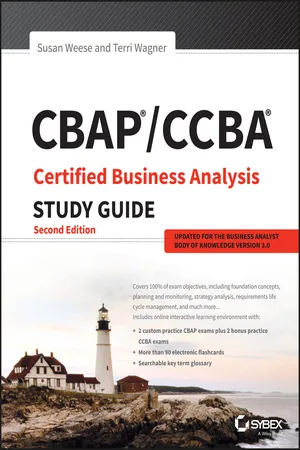
- English
- ePUB (mobile friendly)
- Available on iOS & Android
CBAP / CCBA Certified Business Analysis Study Guide
About this book
The bestselling CBAP/CCBA study guide, updated for exam v3.0
The CBAP/CCBA Certified Business Analysis Study Guide, Second Edition offers 100% coverage of all exam objectives for the Certified Business Analysis Professional (CBAP) and Certification of Competency in Business Analysis (CCBA) exams offered by the International Institute of Business Analysis (IIBA). Detailed coverage encompasses all six knowledge areas defined by the Guide to Business Analysis Body of Knowledge (BABOK): Planning and Monitoring, Elicitation, Requirements Management and Communication, Enterprise Analysis, Requirements Analysis, and Solution Assessment and Validation, including expert guidance toward all underlying competencies. Real-world scenarios help you align your existing experience with the BABOK, and topic summaries, tips and tricks, practice questions, and objective-mapping give you a solid framework for success on the exam. You also gain access to the Sybex interactive learning environment, featuring review questions, electronic flashcards, and four practice exams to help you gauge your understanding and be fully prepared exam day.
As more and more organizations seek to streamline production models, the demand for qualified Business Analysts is growing. This guide provides a personalized study program to help you take your place among those certified in essential business analysis skills.
- Review the BABOK standards and best practices
- Master the core Business Analysis competencies
- Test your preparedness with focused review questions
- Access CBAP and CCBA practice exams, study tools, and more
As the liaison between the customer and the technical team, the Business Analyst is integral to ensuring that the solution satisfies the customer's needs. The BABOK standards codify best practices for this essential role, and the CBAP and CCBA certifications prove your ability to perform them effectively. The CBAP/CCBA Certified Business Analysis Study Guide, Second Edition provides thorough preparation customizable to your needs, to help you maximize your study time and ensure your success.
Frequently asked questions
- Essential is ideal for learners and professionals who enjoy exploring a wide range of subjects. Access the Essential Library with 800,000+ trusted titles and best-sellers across business, personal growth, and the humanities. Includes unlimited reading time and Standard Read Aloud voice.
- Complete: Perfect for advanced learners and researchers needing full, unrestricted access. Unlock 1.4M+ books across hundreds of subjects, including academic and specialized titles. The Complete Plan also includes advanced features like Premium Read Aloud and Research Assistant.
Please note we cannot support devices running on iOS 13 and Android 7 or earlier. Learn more about using the app.
Information
Chapter 1
Foundation Concepts
CBAP®/CCBA™ EXAM TOPICS COVERED IN THIS CHAPTER
- Describe business analysis and the role of the business analyst.

- Explain the Business Analysis Core Concept Model (BACCM™).

- Explore the six business analysis knowledge areas.

- Recognize the basic contents, structure, and intent of the BABOK ® Guide.

- Define the BABOK ® Guide requirements classification scheme.

- Map business analysis activities to a generic project life cycle.

- Understand the content and intent of the BABOK ® Guide.


What Is Business Analysis?
The Business Analyst’s Role
Table of contents
- Cover
- Title page
- Copyright
- Dedication
- Acknowledgments
- About the Authors
- Introduction
- Assessment Test
- Answers to Assessment Test
- Chapter 1 Foundation Concepts
- Chapter 2 Controlled Start: Business Analysis Planning and Monitoring
- Chapter 3 Controlled Start: Strategy Analysis
- Chapter 4 Overarching Tasks: Requirements Life Cycle Management
- Chapter 5 Controlled Middle: Elicitation and Collaboration
- Chapter 6 Controlled Middle: Requirements Analysis and Design Definition
- Chapter 7 Controlled End: Solution Evaluation
- Chapter 8 Underlying Competencies
- Chapter 9 Five Perspectives on Business Analysis
- Appendix A Advice on Completing Your Exam Application
- Appendix B Knowledge Areas, Tasks, and Elements
- Appendix C Mapping Techniques, Stakeholders, and Deliverables to Knowledge Areas and Tasks
- Appendix D Summary of Business Analysis Techniques
- Appendix E Summary of Business Analysis Outputs
- Appendix F Answers to Review Questions
- Advert
- EULA